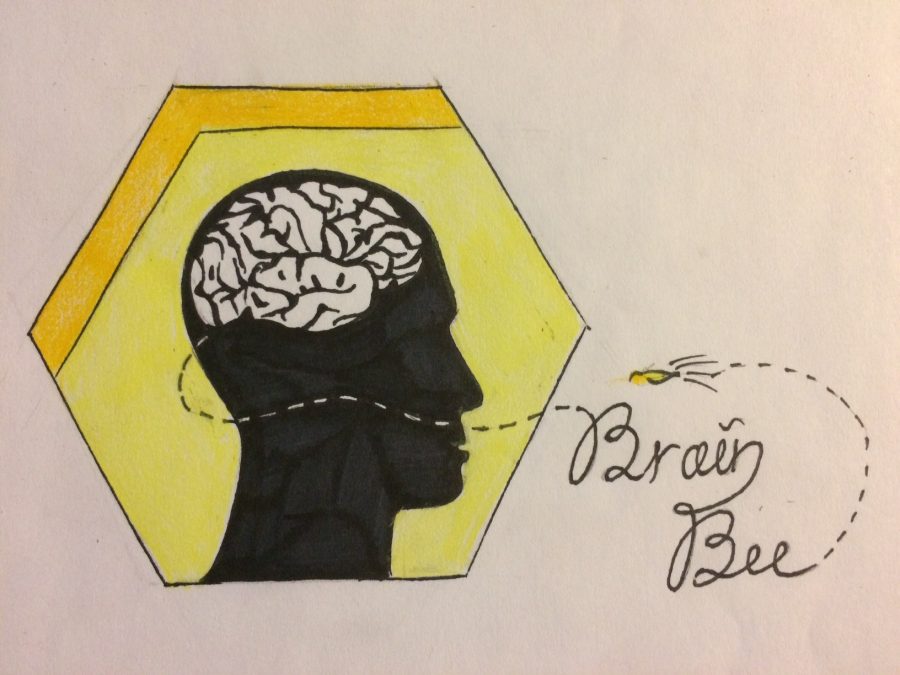Neuroscience and Nerves: The Annual New Jersey Brain Bee
April 7, 2017
The air is so sharp with tension that it could double as a neurosurgeon’s scalpel. High school students cluster in nervous groups, with bowed heads and feverish whispers. Snatches of “Parkinson’s disease,” “hippocampus,” and “inherited retinoblastoma” fly through the air as students clutch sheaves of notes and highlighters. The frenetic sound of flipping pages slicing through the air creates a neurotic symphony.
Today’s the day of the New Jersey Brain Bee, a statewide neuroscience competition that is held annually for high school students. Eighty-or-so students will compete for the first place title, which bequeaths the winner (and a guardian) with an all-expenses paid trip to Baltimore, Maryland, where the National Brain Bee will soon take place.
The competition, which takes place at the Robert Wood Johnson Medical School, is comprised of three different sections. First, all competitors sit for a fifty-question written exam. Then, after the competition’s organizers narrow the pool down to the top twenty scorers, the qualifying scorers undergo a verbal questioning round, in which each contestant orally answers five questions. Finally, the top ten scorers, whose standing is determined by a combination of their written and oral answers, go through a Jeopardy-style final round.
In response to questions that are addressed to all the contests, the contestants have one minute to write down their answers on a whiteboard. The final round is the only elimination round; the judges dismiss contestants after their second incorrect answer. The top three finishers win a sum of money, but only the first place winner gets to compete on a national level.
The first round presents to a challenge to some of the competitors, demanding answers to the tune of “suprachiasmatic nucleus” and “carbidopa.” The sound of tapping pencils pervades the testing hall as a tangible cloud of stress settles over the room.
In between the competitive rounds, the organizers implement different activities that aim to teach contestants a little bit more about neuroscience in the context of college and employment. For example, after the first round, Dr. Huaye Zhang, from Rutgers Department of Neuroscience and Cell Biology, gives a presentation on the different techniques and technologies that research scientists utilize in their work.
Furthermore, during the lunch break, students have the opportunity to tour neurobiology labs and examine dissected brains. Ridge Brain Bee club secretary Shreyes Manivel ’17 attests, “Attending the New Jersey Brain Bee was an enriching experience for me. Not only was I able to showcase my neuroscience knowledge in a competition format, but I was also able to learn more about the current scope of neuroscience research and even touch brains in a gross anatomy lab.”
During this break, contestants also have the chance to ask neuroscientists and college students majoring in neuroscience questions about how they can pursue neuroscience in the future.
Three of Ridge’s own go on to advance to the second round, including senior Shreyes Manivel, junior Renee Ge, and yours truly. The second round is a rollercoaster in and of itself, replete with knocking knees, shaking voices, and, even worse, the dragging thirty seconds of silence that follow of a difficult question. It is during this second round that, in a moment of true tragic irony, yours truly forgets that “amnesia” is defined by “the permanent, long-term loss of memory.”
While the spectating audience, comprised of parents, teachers, and eliminated students, must maintain silence, muted cheers arise from the contestants as they cheer on their classmates. The girl next to me, whose legs are visibly shaking, whispers to me that she and her friends have skipped lunch for three straight weeks in order to study for this competition.
The only Ridge student to advance to the final round is Ge, who faces off ten-some other students for the prize. The third round, while the most high-pressure, is arguably the most chaotic: judges argue amongst themselves and the host struggles to keep track of answers. Unfortunately, Ge, after a particularly tough question, is eliminated along with much of the remaining pool. After a tense round of questions, with the remaining two contenders matching each other question for question, the top three winners are crowned.
Ge ’18 asserts, “Although the competition itself was very nerve-wracking, the lab tour and the lecture made it a great learning experience.”
And even though no one from Ridge returned with a prize, the chance to examine a dissected brain, hear presentations given by neuroscientists, and wolf down free (unlimited!) pizza don’t make for a bad afternoon at all.


Blifsse • Feb 26, 2018 at 1:37 pm
The diction is amazing! Love the strong description as well as the good relation of events. Nice job!
Meghan • Feb 26, 2018 at 1:27 pm
It was really interesting to read about a competition experience and hear about what activities students in our school are participating in.